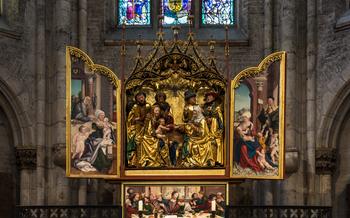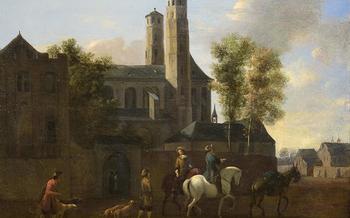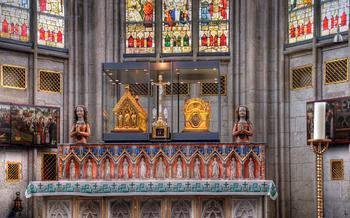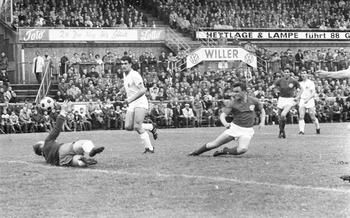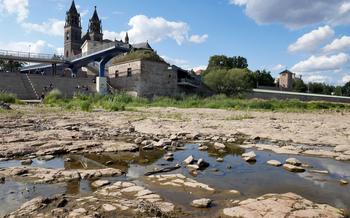
Sankt Michael Church
- Sankt Michael Church: A Majestic Landmark in Paderborn's Heart
- Stepping into the Past: Exploring the Church's History
- A Symphony of Architectural Styles: Romanesque, Gothic, and Baroque Elements
- Awe-Inspiring Interiors: Discover the Church's Treasures
- The Paderborn Cathedral Treasury: A Hidden Gem
- A Place of Worship and Pilgrimage: The Church's Spiritual Significance
- The Crypt: Uncovering the Church's Hidden Depths
- The Tower: Ascending to New Heights for Panoramic Views
- Guided Tours: Unveiling the Church's Secrets with Experts
- Self-Guided Exploration: Discovering the Church at Your Own Pace
- Events and Concerts: Experience the Church's Vibrant Cultural Life
- Accessibility for All: Ensuring an Inclusive Visit
- Respecting Sacred Spaces: Etiquette and Dress Code
- Photography and Social Media: Capturing and Sharing Your Experience
- Insider Tip: Uncovering the Hidden Staircase
Sankt Michael Church: A Majestic Landmark in Paderborn's Heart
Standing tall and proud in the historic city of Paderborn, Germany, Sankt Michael Church is an architectural masterpiece that has captivated hearts and minds for centuries. This awe-inspiring edifice, with its soaring spires and intricately carved facades, is a testament to the city's rich religious and cultural heritage. As you approach the church, its grandeur commands attention, beckoning you to step into a world of history, spirituality, and artistic splendor.
Sankt Michael Church is not just a place of worship; it is a symbol of Paderborn's enduring faith and resilience. Its origins date back to the 11th century, when it was built as a Benedictine monastery church. Over the centuries, it has undergone several expansions and renovations, each adding unique architectural elements that blend harmoniously to create a stunning masterpiece. The church's significance extends beyond its religious function; it has served as a gathering place for the community, a venue for cultural events, and a source of inspiration for artists and scholars throughout history.
As you step inside the church, prepare to be captivated by its breathtaking interiors. The interplay of light and shadow through the stained glass windows creates an ethereal atmosphere that invites contemplation and reverence. Exquisite artwork, sculptures, and intricate carvings adorn every corner, telling stories from the Bible and depicting scenes from the lives of saints. The altar, pulpit, and other furnishings are masterpieces of craftsmanship, each piece contributing to the church's rich visual tapestry.
Stepping into the Past: Exploring the Church's History
The Sankt Michael Church in Paderborn is a testament to centuries of rich history and religious devotion. Its origins can be traced back to the 8th century when Paderborn was a significant religious center under the rule of Charlemagne. The church was initially a modest wooden structure, but it underwent several expansions and renovations over the centuries, reflecting the growing importance of Paderborn as a religious and cultural hub.
In the 11th century, the church was rebuilt in the Romanesque style, and the crypt, which now houses the Paderborn Cathedral Treasury, was added. This period also saw the construction of the distinctive octagonal tower, which became a symbol of the church's power and influence. The tower served as a watchtower, providing a strategic vantage point over the surrounding countryside.
During the 13th century, the church underwent further modifications, incorporating Gothic elements into its design. The nave was enlarged, and the choir was rebuilt in the Gothic style, featuring intricate rib vaults and pointed arches. These architectural changes reflected the changing tastes and influences of the time, as well as the growing wealth and prominence of Paderborn.
The 17th and 18th centuries brought about the addition of Baroque elements to the church's interior. The high altar, pulpit, and other furnishings were adorned with elaborate carvings, gilding, and paintings, reflecting the Baroque style's emphasis on opulence and grandeur. These additions further enriched the church's already impressive artistic and architectural heritage.
Throughout its long history, the Sankt Michael Church has witnessed significant events and milestones. It has been a place of worship, pilgrimage, and cultural exchange, attracting visitors from all walks of life. The church has also been closely associated with various historical figures and religious movements, leaving an indelible mark on the city of Paderborn and its surrounding region.
A Symphony of Architectural Styles: Romanesque, Gothic, and Baroque Elements
The Sankt Michael Church is an architectural masterpiece that showcases a harmonious blend of Romanesque, Gothic, and Baroque elements. The Romanesque style, evident in the sturdy pillars and rounded arches, forms the foundation of the church's design. The Gothic influence is seen in the elegant pointed arches and intricate vaulting, which create a sense of height and grandeur. The Baroque period left its mark in the form of elaborate ornamentation, decorative sculptures, and the striking high altar, which is a testament to the opulence of the era.
Throughout the centuries, the church underwent several modifications and expansions, each contributing to its unique architectural character. The result is a building that seamlessly integrates different styles, creating a cohesive and visually stunning edifice. Here are some practical tips for spotting the architectural highlights of the Sankt Michael Church:
-
Romanesque Elements: Pay attention to the massive pillars and rounded arches in the nave, which are characteristic of the Romanesque style.
-
Gothic Elements: Look for the pointed arches and intricate vaulting in the choir and transepts, which are hallmarks of Gothic architecture.
-
Baroque Elements: Don't miss the elaborate ornamentation, decorative sculptures, and the stunning high altar, which exemplify the Baroque style's grandeur.
-
Unique Blend: Take a moment to appreciate how the different architectural styles come together harmoniously, creating a cohesive and visually stunning edifice.
Awe-Inspiring Interiors: Discover the Church's Treasures
Step inside Sankt Michael Church, and prepare to be captivated by an awe-inspiring display of artistry and devotion. Exquisite artwork, sculptures, and stained glass windows adorn every corner, creating an atmosphere of sacred beauty and wonder. Symbolism and stories are intricately depicted in these intricate decorations, inviting visitors to delve into the rich narratives of the church's history and beliefs.
The altar, a masterpiece of craftsmanship, commands attention with its intricate carvings and opulent ornamentation. Its central panel features a stunning depiction of the crucifixion, surrounded by a chorus of angels and saints. The pulpit, crafted from finely polished wood, stands as a symbol of divine authority and eloquence. Its intricate carvings showcase scenes from the life of Jesus, reminding visitors of his teachings and sacrifices.
The stained glass windows, a kaleidoscope of colors and light, cast an ethereal glow upon the interior. Each window tells a unique story, illustrating biblical scenes, the lives of saints, and the history of the church. The vibrant hues and intricate designs create an atmosphere of reverence and awe, transforming the church into a sanctuary of light and inspiration.
As you explore the church's interior, take time to admire the smaller details that add to its charm and significance. The intricate carvings on the pews, the delicate frescoes adorning the walls, and the ornate chandeliers hanging from the ceiling all contribute to the church's unique aesthetic. Each element, no matter how small, has been carefully crafted to enhance the overall experience, making Sankt Michael Church a true treasure trove of artistic and spiritual wonders.
The Paderborn Cathedral Treasury: A Hidden Gem
Concealed within the depths of Sankt Michael Church lies a treasure trove of ecclesiastical wonders: the Paderborn Cathedral Treasury. Located in the heart of the church, near the altar, this hidden gem is a testament to the rich history and religious significance of Paderborn. Visitors can access the treasury through guided tours or by requesting permission from the church office.
The treasury showcases a dazzling array of artifacts, relics, and religious objects that have been meticulously preserved over centuries. Among the highlights are intricately crafted gold and silver chalices, ornate reliquaries adorned with precious stones, and elaborately embroidered vestments. These objects not only possess artistic value but also hold deep historical and cultural significance.
The treasury also houses a collection of rare and ancient manuscripts, including illuminated manuscripts that offer a glimpse into the region's medieval past. Visitors can marvel at the intricate calligraphy, vibrant colors, and beautiful illustrations that adorn these precious volumes.
A visit to the Paderborn Cathedral Treasury is a unique opportunity to delve into the spiritual and cultural heritage of Paderborn. Whether you are a history buff, an art enthusiast, or simply seeking a deeper connection to the sacred, this hidden gem is sure to captivate and inspire.
Practical Tips:
- Guided tours of the treasury are highly recommended, as they provide expert insights into the history and significance of the collection.
- Photography is generally not permitted inside the treasury, but visitors may inquire with the church office for special permissions.
- The treasury is open to the public during specific hours, so it is advisable to check the church's website or contact the office for the most up-to-date information.
- Visitors are encouraged to handle the artifacts with care and respect, as they are irreplaceable treasures of the church's heritage.
A Place of Worship and Pilgrimage: The Church's Spiritual Significance
Sankt Michael Church is not just a historical and architectural marvel; it holds immense spiritual significance to the people of Paderborn and beyond. For centuries, the church has been a place of worship, pilgrimage, and devotion. The faithful flock to the church to seek spiritual guidance, offer prayers, and connect with the divine.
Pilgrimages to Sankt Michael Church have been taking place for centuries. Many pilgrims believe that the church possesses miraculous powers and that prayers offered here are particularly powerful. There have been numerous accounts of healings, answered prayers, and spiritual transformations attributed to the church.
One of the most famous pilgrimages associated with Sankt Michael Church is the "Michaelisprozession," which takes place annually on September 29th. Thousands of pilgrims from across the region gather in Paderborn to participate in this procession, which commemorates the dedication of the church.
The church is also known for its association with various religious movements and spiritual figures. In the 18th century, the church was a center of the Pietist movement, which emphasized personal piety and inner devotion. Several prominent Pietist preachers and theologians served at the church, leaving a lasting impact on its spiritual legacy.
For visitors seeking a spiritual connection, Sankt Michael Church offers a serene and sacred environment. The church's beautiful architecture, intricate artwork, and rich history combine to create a truly awe-inspiring and uplifting experience. Whether you are a devout believer or simply someone seeking a moment of peace and reflection, Sankt Michael Church is sure to leave a lasting impression on your soul.
The Crypt: Uncovering the Church's Hidden Depths
Beneath the grandeur of Sankt Michael Church lies a hidden realm of history and reverence—the crypt. Descend the worn steps to this subterranean sanctuary, where time seems to stand still amidst the echoes of centuries past. Originally conceived as a burial ground for Paderborn's ecclesiastical elite, the crypt holds the remains of bishops, priests, and other notable figures who played a significant role in shaping the church's legacy.
As you navigate the dimly lit corridors, you'll encounter a series of vaulted chambers, each adorned with intricate carvings and inscriptions that tell the stories of those laid to rest here. Among them lies Bishop Meinwerk, the visionary who oversaw the construction of the church and left an indelible mark on Paderborn's history. His elaborate tomb, adorned with biblical scenes and symbols of his faith, stands as a testament to his devotion and leadership.
The crypt also holds the remains of other prominent individuals, including members of the Paderborn Cathedral Chapter and wealthy benefactors who contributed to the church's construction and embellishment. Their tombs and epitaphs provide a glimpse into the lives and legacies of those who dedicated their lives to serving the church and the community.
Exploring the crypt is a unique opportunity to delve into the hidden depths of Sankt Michael Church and gain a deeper understanding of its history and significance. It's a place where the past and present intertwine, where the echoes of prayers and chants still linger in the air. As you pay your respects to those who have gone before, you can't help but feel a sense of awe and reverence for the enduring spirit of this sacred space.
The Tower: Ascending to New Heights for Panoramic Views
Reaching towards the heavens, the tower of Sankt Michael Church stands as a testament to human ingenuity and architectural prowess. Its imposing height offers visitors a unique perspective, allowing them to gaze upon Paderborn and its picturesque surroundings. The ascent to the tower's summit is an experience in itself, as visitors climb the winding stone staircase, their anticipation building with every step.
Upon reaching the tower's peak, visitors are greeted with a breathtaking panorama that stretches far and wide. The city of Paderborn unfolds below, its red-tiled roofs and spires creating a vibrant tapestry. The rolling hills of the Teutoburg Forest provide a verdant backdrop, while the distant peaks of the Harz Mountains add a touch of drama to the horizon.
In addition to the stunning views, the tower also holds historical significance. It once served as a watchtower, providing a strategic vantage point for spotting approaching enemies. The tower's sturdy construction and commanding height made it an integral part of Paderborn's defenses, ensuring the city's safety and security.
Today, the tower stands as a symbol of Paderborn's rich history and enduring spirit. Its panoramic views offer visitors a glimpse into the city's past, present, and future, making it a must-visit attraction for anyone seeking a truly unforgettable experience.
-
Practical Information:
-
The tower is open to visitors during regular church hours.
- Admission fees may apply, and guided tours are available upon request.
- The climb to the tower's summit involves narrow staircases and may not be suitable for visitors with mobility issues.
- Remember your camera to capture the stunning views from the top.
Guided Tours: Unveiling the Church's Secrets with Experts
Exploring Sankt Michael Church with a knowledgeable guide is an enriching experience that unlocks the hidden stories and significance of this sacred site. Guided tours are available in various languages and cater to different interests, whether you're a history buff, an architecture enthusiast, or a pilgrim seeking spiritual insights.
Benefits of Guided Tours:
-
Expert Knowledge: Guides share in-depth information about the church's history, architectural styles, religious significance, and anecdotes that bring the past to life.
-
Personalized Experience: Tours can be tailored to your specific interests, allowing you to delve deeper into aspects that resonate with you.
-
Unveiling Hidden Gems: Guides often reveal hidden corners, secret passages, and lesser-known stories that you might miss on your own.
Practical Tips for Booking a Guided Tour:
-
Advance Booking: Reserve your spot in advance, especially during peak tourist season, to avoid disappointment.
-
Choose Your Language: Tours are available in multiple languages, including English, German, and Spanish. Select the language that suits you best.
-
Duration and Cost: Tours typically last around 60 to 90 minutes and may vary in cost. Check the church's website or inquire at the information desk for details.
-
Group Size: Group sizes are usually limited to ensure a personalized experience. Smaller groups offer more opportunities for interaction with the guide.
Making the Most of Your Guided Tour:
-
Ask Questions: Don't hesitate to ask questions throughout the tour to clarify doubts and gain additional insights.
-
Engage with the Guide: Share your thoughts, experiences, and questions with the guide to foster a lively and interactive discussion.
-
Take Notes: If you're particularly interested in certain details, bring a notepad to jot down key information or questions for later research.
-
Respect the Church's Sanctity: While engaging with the guide, remember to maintain a respectful tone and volume, mindful of the sacred nature of the site.
Self-Guided Exploration: Discovering the Church at Your Own Pace
For those who prefer a more independent exploration, self-guided tours of Sankt Michael Church offer a unique opportunity to discover its treasures at your own pace. Detailed maps and guides are available at the entrance, providing information on the church's history, architecture, and significant features.
Begin your self-guided tour by admiring the imposing facade, taking note of the intricate carvings and sculptures that adorn the doorways. Step inside and let your eyes adjust to the dimly lit interior, revealing the stunning stained glass windows that cast a colorful glow on the grand nave.
Follow the suggested route to explore the various chapels and side altars, each dedicated to different saints and adorned with unique artwork. Take your time to appreciate the exquisite craftsmanship of the altarpieces, sculptures, and intricate carvings that tell stories from the Bible and the lives of the saints.
Don't miss the opportunity to ascend the spiral staircase to the choir loft, where you can enjoy a closer look at the impressive organ and admire the intricate details of the vaulted ceiling. For a serene moment of reflection, find a quiet corner to sit and soak in the tranquility of this sacred space.
Whether you're an art enthusiast, a history buff, or simply seeking spiritual connection, a self-guided tour of Sankt Michael Church allows you to delve deep into its rich heritage and discover its hidden gems at your own leisure.
Events and Concerts: Experience the Church's Vibrant Cultural Life
Sankt Michael Church is not just a place of worship but also a vibrant cultural hub. Throughout the year, the church hosts a variety of events and concerts that showcase its stunning acoustics and provide a unique and immersive experience for visitors. From classical music concerts and choir performances to organ recitals and contemporary music events, there's something for every taste and preference.
The church's annual concert series, "Musica Sacra Paderborn," is a highlight of the city's cultural calendar. This prestigious series features renowned musicians and ensembles performing a diverse repertoire of sacred music, from Gregorian chant to modern compositions. The concerts take place in the church's awe-inspiring interior, creating an intimate and magical atmosphere.
For those who prefer a more contemporary vibe, the church also hosts regular events and concerts featuring local and international artists from various genres. These events often showcase experimental music, electronic music, and world music, transforming the sacred space into a vibrant and dynamic venue.
To stay updated on upcoming events and concerts, visitors can check the church's official website or social media pages. Tickets can be purchased online or at the church's box office. Whether you're a music enthusiast or simply looking for a unique and memorable experience, attending an event or concert at Sankt Michael Church is a must.
Accessibility for All: Ensuring an Inclusive Visit
Sankt Michael Church embraces inclusivity, ensuring that all visitors, regardless of their abilities, can fully experience its architectural and spiritual wonders. Wheelchair accessibility is a priority, with ramps and elevators seamlessly connecting different levels of the church. Visitors with special needs can request assistance from the friendly staff, who are always ready to provide support and accommodations. Whether you have mobility challenges or require additional assistance, the church's welcoming atmosphere and accessible features guarantee an enriching and fulfilling visit for everyone. Practical tip: Plan your visit in advance and inform the church about any specific needs or preferences to ensure a smooth and enjoyable experience.
Respecting Sacred Spaces: Etiquette and Dress Code
When visiting Sankt Michael Church, it is crucial to be mindful of its sacred nature and observe proper etiquette. Appropriate attire is essential, with visitors expected to dress modestly and respectfully. Avoid wearing shorts, tank tops, or revealing clothing that may be deemed inappropriate for a religious setting.
Maintaining silence and reverence is another important aspect of respecting the church's sanctity. Refrain from loud conversations, laughter, or any behavior that may disrupt the peaceful atmosphere. Be considerate of other visitors who are seeking a moment of contemplation or prayer.
It is also essential to adhere to local customs and traditions. In Paderborn, it is customary to greet others with a friendly "Guten Tag" (Good Day) or "Grüß Gott" (God's Greeting). When entering the church, it is customary to bow or nod your head in reverence towards the altar.
By following these guidelines, visitors can contribute to preserving the sacredness of Sankt Michael Church and ensure a respectful and meaningful experience for all.
Photography and Social Media: Capturing and Sharing Your Experience
With its stunning architecture, awe-inspiring interiors, and sacred atmosphere, Sankt Michael Church presents countless photo opportunities. While capturing the beauty of the church through your lens, it is essential to be mindful of the sacred nature of the site. Respect the privacy of other visitors by avoiding intrusive photography and maintain silence to preserve the tranquility of the space.
Before using your camera, check for any signs or guidelines regarding photography within the church. Typically, flash photography is prohibited to protect delicate artworks and interiors. If using a tripod, ensure it does not obstruct the passage of other visitors or impede their worship.
Embrace the opportunity to share your experience on social media, but do so responsibly. Tag the church's official social media handles and use relevant hashtags to connect with other visitors and enthusiasts. Consider adding historical or architectural insights to your posts, helping others appreciate the significance of the site beyond its visual appeal.
Remember, your social media presence can play a role in promoting the church and encouraging others to visit. Share your awe-inspiring shots, but always prioritize respect for the sacred space and the privacy of fellow visitors.
Insider Tip: Uncovering the Hidden Staircase
Amidst the grandeur of Sankt Michael Church, a hidden gem awaits discovery—the mysterious hidden staircase. Concealed within the church's walls, this staircase has borne witness to centuries of history, untold stories, and whispered secrets.
Accessible through an unassuming door, the staircase spirals upward, leading to a hidden chamber that offers a unique perspective of the church's interior. From this vantage point, visitors can admire the intricate details of the vaulted ceilings, the vibrant hues of the stained glass windows, and the sheer scale of the nave.
Legends abound regarding the hidden staircase. Some say it was used by monks to access secret chambers or to escape during times of danger. Others believe it was a passageway for pilgrims to reach hidden shrines or to perform clandestine rituals.
Whatever its true purpose, the hidden staircase adds an aura of mystery and intrigue to Sankt Michael Church. Discovering it is like uncovering a secret treasure, a hidden gem that enhances the visitor's experience and leaves them with a lasting memory of this remarkable place of worship.
Practical Tip: To find the hidden staircase, look for an unassuming door near the choir stalls. Please be respectful and mindful of your surroundings when exploring the staircase, as it is a sacred space that should be treated with reverence.


